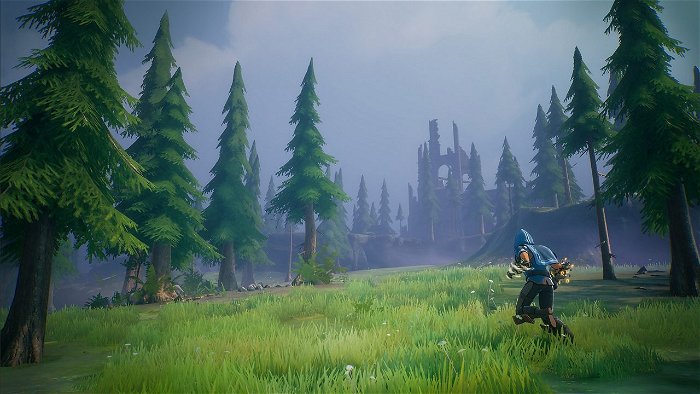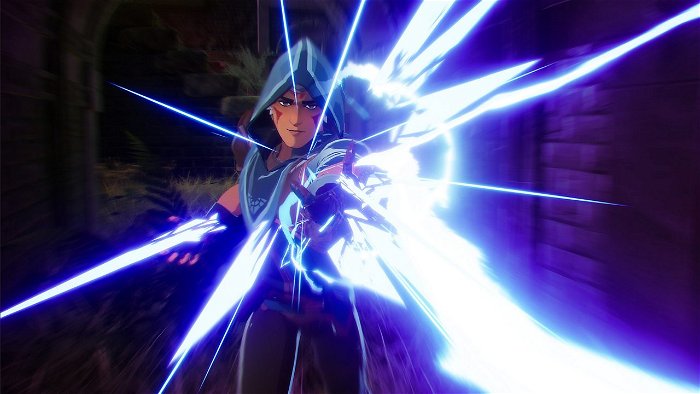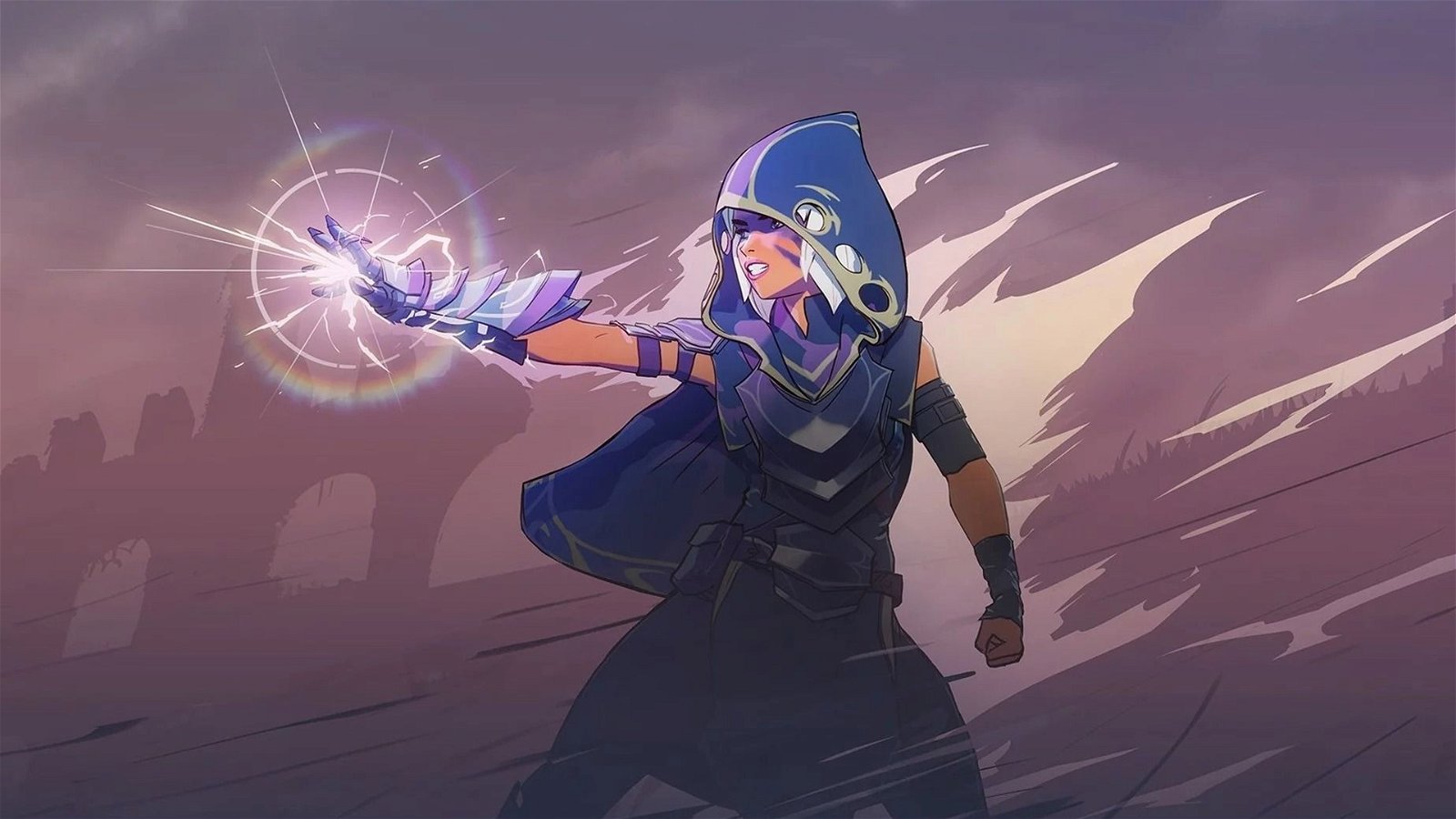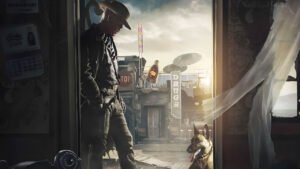Spellbreak is the latest Battle Royale from developer Proletariat Inc. that looks to add a new trick in a saturated genre.
With household staples like Fortnite, Apex Legends, PUBG and Call of Duty Warzone, what ties each game are its use of guns in a technologically advanced setting – a pattern Spellbreak breaks through its mystical setting. Familiar, but welcome visuals of spell casting and medieval sorcery are rampant across Proletariat’s latest world. It’s trade-off also includes creating a new interpretation of massive free-for-alls between battlemages, under a unique blend of Cel-shaded VFX and detailed environments.
These features are also lead by Insomniac Games veteran, Proletariat Co-founder and Art Director Damon Iannuzzelli, who put on various hats across Spellbreak‘s early development. Through experimenting with different 2D effects across a 3D plane, Iannuzzelli also helped put elemental power in the hands of players as they conjure and throw out attacks. The game also features the mysterious Hollow Realm players would be getting to know from a third-person view – something which brings together Spellbreak‘s large and open range confrontations.
CGMagazine sat down remotely with Iannuzzelli to learn more about Spellbreak‘s influences towards a new (gun-free) BR contender, and how the game’s visual effects also shaped its world and characters.
CGMagazine: Right when you and the team we’re coming up with Spellbreak’s art design and the concept for wizarding Battle Royale, what were some of the first visual that came to mind?
Damon Iannuzzelli: Yeah, interestingly the game actually started as a little bit more grounded in realism. Kind of swords and bows and arrows. I actually was gone for maternity leave for about a month, and when I came back, the game had completely changed (laughs) overnight. Our Chief Game Director had gone over the entire weekend and re-prototyped the entire game into this kind of like magic shooter.
And so just like the way that the game played it, that sort of pivotal moment felt like it demanded a very new and different visual style than the realistic types of stuff we’ve been chasing down for most of development at that point. We had about eight weeks before GDC and at that point and we just like, really quickly brainstormed what we want to do.
I think the magic combat; very, very early on initially felt like it wanted to be close to having that anime kind of feel. And so, we decided we were going to chase down those associated characters under a more painterly looking background. We prototyped all of that in about eight weeks and sort of brightened it up a bit, to make things a little bit more approachable and give it some accessibility through lighting, and to give the moodier areas an overall lighter kind of world. But that’s really what it came down to. And so we wanted to build our whole look around something that already had some cultural identity around action, magic and superpowers.

CGMagazine: And pretty early on when you were coming up with Spellbreak, was going wizarding the only concept, theme and setting that you wanted to go with? Or were there others originally in different settings that you wanted to try out?
Damon Iannuzzelli: Once we were striving for magic combat, wizards and battle mages in the world, we wanted to keep that in a fantasy world. We didn’t go for a “Wizards in New York” kind of thing. I think there were questions about how high or low the fantasy would be, meaning would it be really grounded and familiar-looking? Something like, for a better word, like Game of Thrones, which is actually filmed in real locations a lot of times and contained a historical, European look. Or, something like Final Fantasy where there’s a very high fantasy world where there’s a crystal glass castle floating in the air and everything. So we kind of decided to keep things fairly familiar and grounded with some more natural-looking and historical looks to balance the more explosive, wild and crazy superhero antics. I think by doing that, it just allows us to do much wilder things with the gameplay or with storytelling if we bring them (players) in and you know, not weird them out right off the bat with everything we’re throwing at them basically.
CGMagazine: And when drawing up specific parts of the map, did you set them up with any possible changes for the future, knowing that this game is going to be continuous?
Damon Iannuzzelli: Yeah for sure. In fact, we’re launching with a number of partially finished areas. You know, we try to get them up to a sort of polished level. Within one of our early live releases is a whole portion of the map that is going to be changing its whole digital identity. Because you know, when we’re trying to make all the regions of the map feel interesting and developing our reality of wanting to get the game out to players as early as we could – and on all the platforms we’re launching on. So we also had to make some compromises there. Around what we can launch with, versus our overall ambition that we can fit. The map is built in a very dynamic method to grow and change with each release. Some of that will be around bringing brand new sorts of narrative storytelling to the in-game experience, and some elements would be like actually bringing up things (that are already in the map) to the level in a finished style of visual quality we always wanted but weren’t able to make by launch.
CGMagazine: Did the varying PC and console requirements affect the way Spellbreak presents itself over these platforms? Did you have to tweak your art style knowing it had to be translated into gameplay and performance?
Damon Iannuzzelli: There was a late stage platform that we added which did require going back through assets that we made. But in general, we were really able to pretty easily throttle up and bottle down the visual quality that’s across those platforms (Console, PC, Switch).
CGMagazine: Was there one platform that was harder to work with than the others?
Damon Iannuzzelli: You know, I would say that if you compare like our high end PCs to like executing on Nintendo Switch, there’s definitely some challenges there. But I think, you know, we’re able to sort of get the experience across to people on the Switch, so it was pretty valuable we were able to accomplish that. You can battle with 40 people on the Switch at 30 frames-per-second and they’re all under the visual styling. So that’s a sort of big one.
CGMagazine: And I also wanted to step it back to the map design a little bit. Of course, with Spellbreak having an open world Battle Royale map, how does each section of the game blend in with each other?
Damon Iannuzzelli: If you go into the map, some of them are hard transitions. There’s a little bit of a technology restriction there around how much you can (stitch) a bunch of different sections blending into each other and what not. But I think we got it pretty elaborately. We actually had to sort of see how the map fit and there’s kind of a cataclysmic event that happens in the game called the Fracture, and we had to dig into the kind of earthquake fractures while we were combing through the map. It helps kind of give us sort of a hard line separation between certain regions and an easy way to describe that hard line doesn’t feel you know, arbitrarily crossing from gaps and into the desert (laughs). So we sort of built these kinds of nice visual boundaries off the region separation as you know already. And then we have kind of faded a little bit of technology to chain and blend different lighting and fog values and other atmospherics that feel a little bit different when you’re running from the grassland into other regions. And to better areas that are much hotter and sunsets to really feel that heat and the dryness of the air there. In the effect of a nice summer day and the temperatures.

So there’s a region of the map, kind of in the middle that was filled with interesting rock structures and what not. We kind of had to turn it into a big mountain, partially because we actually wanted like a big mountain in the middle of the map. Because we generally didn’t have enough for that kind of a geographic height variation, so we wanted there to be this like, nice, big monumental thing in the middle of the map people could use to orient themselves.
CGMagazine: And I also noticed as well with a lot of Battle Royales, there are some places where people can go out in the open and start looting before fighting people in open areas. There are some people who are just also like going in the buildings a lot or just waiting it out. Did the team kind of keep that in mind while they were designing the map?
Damon Iannuzzelli: It’s a little bit more of a confrontational game. It’s not quite the sort of like working on hiding-out-in-buildings kind of game. On the visuals, that’s actually a kind of benefit. We don’t spend as much time building super complicated interior architectural spaces, in addition to making buildings look beautiful on the outside. So the building interiors that people can roam and loot in tend to be a little bit more open than what they (BRs) usually have. So in a post-Fracture world, there’s a lot different things like holes and walls that people can find themselves in. If you think about it, it’s a little bit more like a platformer-shooter, versus; you’re not really gonna walk into a single building and explore like every hallway. It’s more of a fast-forward action game where we put a short and protractive form of interior exploration. It’s a little more about faster decision-making and circle-closure and fast combat.
CGMagazine: Of course, the environment is obviously also a grounds for doing all sorts of different things. And what are some of the ways the environment itself reacts the players during really intense fights?
Damon Iannuzzelli: Oh, that’s a good one. So pretty earlier in Spellbreak’s development, one of the pieces in the game’s combat is that these magic elements all sort of bump together to make different spell versions and interactions. So you could shoot out a poison cloud and pop a fireball in it and it explodes. And we needed to incorporate that into the environment a lot more. It turns out that working on the environment more than action only started to add too much gap to the game, in something that already has fast decision making combat going on. The thing that every game developer wants to do is just like “make the whole world destructible, you can just kill everything.” Practically speaking though, in a multiplayer game we ended up avoiding it. It’s certainly possible. It creates a lot of interesting design results that you know, we weren’t really prepared to sort of fully answer and test.

CGMagazine: For sure. And of course a lot of Spellbreak’s destructions obviously come from the spells players are going to be making. I noticed that many of the spells of course are based on different elements and how did you come around in making each of them look unique?
Damon Iannuzzelli: We want to make sure the elements and the magic is very understandable. So with Fire, Lightning, Ice, Toxic, Wind, you know we wanted to make sure they were easily identifiable from the get-go. There’s no sense in making fire blue because then you have to explain why it’s Blue. So we try to keep things fairly grounded in the natural. And then we kind of went through a consistent shape language for each of these magic flames. So, again fire has pretty consistently very, juicy fiery edges with flat, billowy smoke. The Toxic magic is all very bright, very opaque green. So we try to create a highly identifiable palette and identifiable shapes that work through any of this game’s development. The really interesting thing is what happens when they combine, we’re literally just like trying to combine two shape-lines and the palette to create things, like if you ignite know the wind for a tornado, and then fire to piece the sort of shape language. We keep the change language of the tornado, but we used the palette language of the fire to keep things in an understandable way.
Hopefully, we don’t have to spend too much time training players on what they’re seeing and they can understand it to a degree. We spent a really long time trying to figure out what you’re gonna do for how magic should be passed in the game. How should it look, how should it sound, how should it feel and the easy thing, I think what we thought of first was magic wands. But they don’t feel like combat to me. There’s lots of great scenes in Harry Potter with users using magic wands that are really cool, but I couldn’t see us using magic wands as a combat implement. So that’s why we came up with these gauntlets. We give you these magic weapons which was something that felt a little bit more badass.

And then Doctor Strange came out a few years ago, which added another person we took a look at for sounds, tones and these kind of elaborate, unique things like tracings in the air. And then of course there’s the sort of elemental magic happening in The Last Airbender and The Legend of Korra, which felt very physical. They were basically conjuring up real physical elements, from the sound work and the visuals all all those effects sort of felt very grounded in reality and that’s kind of what we decided to want to make players feel like they have a very physical center and it wasn’t all just, you know, theory or magic conjuring or you know, spells with like arcane language. You’re really just bringing like actual fire into the world.
CGMagazine: And of course a lot of the cosmetics are also taking part of this unique art style. And what was it like getting to design a variety of different customizations for characters that players can unlock in the game? Do they all come with some kind of a visual theme?
Damon Iannuzzelli: I think one of the interesting things, especially with the cosmetics is there’s an expectation that we’re going to serve lots of different identities and tropes and sort of themes. We also have to include lots of diverse options for a global player base out there. I think the most interesting challenge there is going to be when we start producing things like holiday content for, you know, certain tropes that maybe don’t quite match so well with the fantasy battle royale. Just the fair expectations of what you get from the cosmetic system, and making sure to filter through the lens of being a battle mage within Spellbreak. As you know there will definitely be some challenging holidays. So we’re trying to make sure it all feels like it belongs in the world, they grasp each other and ultimately knowing all that stuff is stuff that players want.
Spellbreak will be launching as a free-to-play battle royale for PC, PS4, Xbox One and the Nintendo Switch in 2020.




